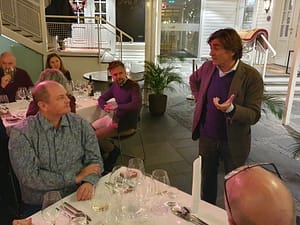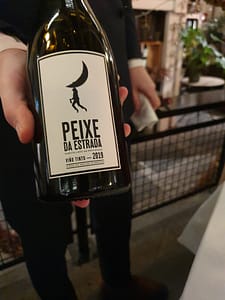An armada of Spanish producers visited Stavanger, Norway this last Tuesday with their importer Moestue Grape Selections. I participated at the following dinner at Matbaren Renaa.
Visiting from Spain were Telmo Rodríguez, Fernando García (Comando G) and Carlos “Curro” Bareño (Fedellos and Vinícola Mentridiana). Pedro Parra from Itata, Chile should have been there, but was left somewhere in Europe with covid.
Paired with the restaurant’s lobster, lamb and quail dishes were seven wines. The fino Caberrubia Saca VI from Luís Pérez was a welcome drink, a natural sherry from pago Balbaína outside Jerez. It’s a grapey, salty and fresh sherry with no added alcohol.

Telmo Rodríguez introduced his white Branco de Santa Cruz 2020 from Valdeorras. He tells that this is one of the places he spends most time nowadays. It’s made from that premium northern grape godello, with some treixadura, doña blanca and palomino, all found in a mixed vineyard together with red varieties, and matured in used oak vats. It’s a super elegant wine with good volume, textured, and a complex aroma of citrus, herbs, a touch of menthol and a stony minerality.

Fedellos started as Fedellos do Couto because they were based in that village. Now they have moved. They make wines from the Bibei valley. Peixe da Estrada 2019 is a village wine from Viana do Bolo outside both Valdeorras and Ribeira Sacra designated areas, a field blend of 60-80 year old vines with predominantly mencía made with whole bunches in partially used barrels, steel, concrete and/or fiberglass tanks. Long maceration time and light extractions. It’s a fresh, delicate wine with aromas of red and dark fruits along with herbs and some balsamic.

Pedro Parra couldn’t attend as he was sick with covid and stuck somewhere in Europe. But his wines made it to Norway. Pedro is a leading figure in the new terroir-focused Chilean wave, concentrating on cinsault on granite soils. He tries to make his wines in a reductive way, at present with 20 days skin-contact.
Trane was obviously (?) dedicated to John Coltrane, an innovator and creative jazz musician. It’s a single-vineyard cinsault from a plot of highly decomposed granite soils. It fermented in concrete with indigenous yeasts and some 30% full clusters and matured in big oak vats for 11 months. It’s a light wine, but also structured. The fruit is both dark and red, with hints of flowers, anise and smoke.

Fernando García represented Comando G, that has contributed to putting the Gredos mountains on the wine map. They were also on this trip promoting the book Calicata, about the wine region. The English edition was released a few months ago, and Moestue sells it on the Norwegian market. In fact I was visiting Fernando at his table when another wine was passed around. I didn’t realize this in time, but my fiancée gave me a few drops to taste. It had a strong signature of a Gredos garnacha, ruby red, ethereal, with red fruits (raspberry), flowers and smoke – in a way light, but intensely full of flavours. It turned out to be Las Iruelas 2019, a parcel wine from El Tiemblo in the Ávila province. It was earlier made by the Jiménez-Landi family winery, but is now labelled Comando G.
The last wine was a lovely rioja from the new wave, that I advocate, Telmo’s Tabuérniga 2019. It comes from a cool vineyard in the village of Labastida, planted with old tempranillo vines, some graciano, mazuelo, garnacha and garnacha blanca. The soil is shallow and calcareous. It’s a serious wine; somewhat austere and maybe a little closed, but underneath are red and wild berries waiting to burst; it’s full of fruit and the tannins are elegant. It’s a wine that invites you to meet again, so let’s remember it and follow. A wonderful evidence that a wine does not need to be oaky to be complex nor ageworthy.








